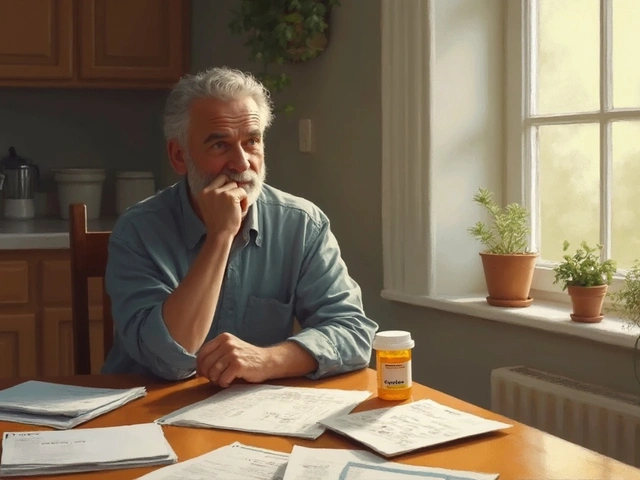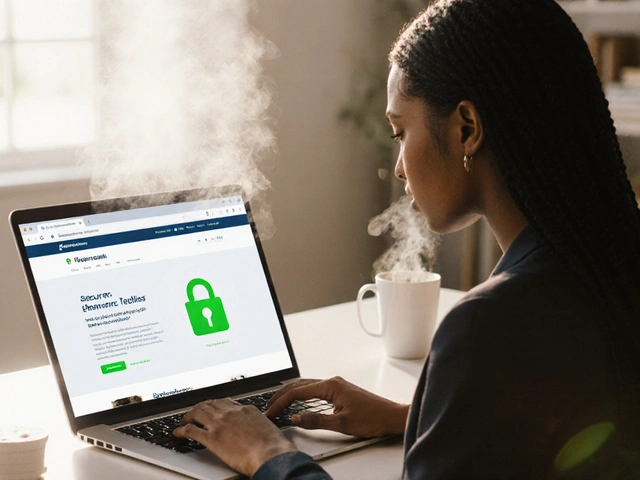If you’ve ever had a nasty throat infection that left you sounding like a croaking frog, there’s a fair chance your doctor handed you a box of Keftab. This isn’t some new kid on the block. Keftab, with its active ingredient cephalexin, has been fighting bacteria since the 1970s. But don’t let its age fool you—it’s still one of the go-to weapons for beating those annoying bacterial infections.
How Does Keftab Work and When Should You Use It?
Keftab operates like a tiny demolition team targeting only the bad guys: bacteria. Its active component, cephalexin, is a member of the cephalosporin family of antibiotics. Here’s how it works: it breaks down the bacterial cell wall—just like someone punching holes through a fortress. No wall, no life. That’s why it’s especially good for killing bacteria that can’t defend themselves against this particular attack.
People tend to meet Keftab mostly for throat infections, ear infections, sinusitis, and skin infections. It often tackles urinary tract infections (UTIs) and some dental infections too. It isn’t a cure-all: Keftab doesn’t touch viruses at all. That means it won’t help your cold or the flu. This is a pretty big deal, because there’s still a lot of confusion about when antibiotics are helpful. Taking it for the wrong problem just feeds antibiotic resistance, which makes life harder for everyone.
If you’ve picked up a prescription for Keftab, it’s usually for pretty common bugs like Streptococcus (the one famous for strep throat), Staphylococcus, or E. coli. It covers a heap of different bacteria, but not every single kind. That's why you’re better off not borrowing a friend’s leftover pills just because you both have a cough. Doctors sometimes even ask for a swab to make sure Keftab is the right match for your infection. Here’s why: the overuse and misuse of antibiotics are making some bacteria much tougher to treat. The World Health Organization keeps sounding the alarm that antimicrobial resistance could become one of the world’s top health threats if we’re not careful.
Here in Australia, Keftab comes in handy when penicillin isn’t an option—maybe you’re allergic or have other reasons to avoid it. It tends to work fast for things like sore throats, with lots of folks feeling better in two or three days. Still, you shouldn’t stop early; bacteria love it when you give up halfway. Even if you’re feeling good after a day or two, finish your course. If not, surviving bacteria can go on to multiply and come back stronger. This is one of the simplest but most important tips for taking antibiotics correctly.
Doctors usually prescribe Keftab as tablets or capsules, sometimes as a liquid for kids. Absorption is pretty quick—about an hour—and the medicine spreads throughout your body, especially targeting the infection. Because it passes through your kidneys, you’ll want to mention any problems you have there to your doctor. In one study, patients with healthy kidneys cleared Keftab in roughly 8 hours, but in people with kidney problems, it lingered longer. That’s why dosage adjustments matter, and your doc will make sure you’re getting the right amount for your situation.
So, the main takeaways for using Keftab safely:
- Only use it for bacterial infections diagnosed by a doctor.
- Finish your prescribed course even if you feel better.
- Share your allergies and medical history, especially about kidneys or gut problems.
- Don’t share antibiotics with others or use leftovers.
A clinic here in Melbourne handed out nearly 2,400 prescriptions for cephalexin in 2024 alone, according to a local GP’s data. Its popularity speaks for itself, but the most responsible way to use it is only under medical advice, never “just in case.”

Keftab Dosage, How to Take It, and What to Watch For
The dosing for Keftab is not one-size-fits-all. It depends on your age, the kind of infection you have, and your health status. For adults, a typical dose might be 250 mg every six hours, or sometimes 500 mg every twelve hours, depending on your doctor’s orders. Some skin and throat infections do better on the lower end. Kid’s doses get calculated by weight—doctor’s call. Trust them on this; underdosing can be just as much of a problem as overdosing.
There are a few good habits worth remembering when it comes to taking Keftab:
- Stick to a schedule—set reminders so you don’t miss a dose.
- Take it with or without food, but if it upsets your stomach, try it with a meal or a cracker.
- Don’t crush or chew the capsules unless your doctor says it’s fine.
- If you miss a dose, take it as soon as you remember. If it’s close to the next dose, just skip it.
- No double dosing to catch up. That never ends well.
Some pharmacies in Australia even provide a little chart, so you can tick off doses as you go. A minor thing, but when you’re sick and distracted, it’s surprisingly easy to forget.
Side effects? Most people get away with very mild ones—or none at all. The most common things you might notice are stomach upset, mild diarrhea, or, occasionally, a bit of nausea. A few folks get a rash or itching. Sometimes there’s a little headache or dizziness, but these are less common. If you’re the unlucky type or have allergies to antibiotics, there are rarer side effects doctors worry about:
- Severe rash or hives
- Swelling of the lips or face
- Trouble breathing (get medical help fast if this happens)
- Watery or bloody diarrhea, especially if it persists (could be a sign of a gut infection called C. difficile—rare, but serious)
- Yellowing of eyes or skin (which could suggest liver trouble)
Kids and older adults are slightly more likely to get side effects, and your doctor might monitor things like kidney function during a course if you have pre-existing health issues. Women who are pregnant or breastfeeding usually can take cephalexin safely, but always check with a doctor first.
Since Keftab is cleared through kidneys, if your kidney function isn’t tip-top, your doctor will tweak your dose. Here’s a quick look at how Keftab is processed in the body:
| Group | Time to Clear Keftab from Body |
|---|---|
| Healthy adults | 6-8 hours |
| Severe kidney impairment | 12-24 hours |
| Children | 5-7 hours |
If you’re on other medications, let your doctor know. While serious drug interactions are rare, some things like probenecid (for gout) can affect how long Keftab stays in your system. Tablets of iron or zinc can sometimes lower Keftab absorption, so spacing them out from your antibiotic is smart.
If you develop thrush (white patches in the mouth) during treatment, that’s a sign the medicine has also killed off friendly bacteria. It sounds grim, but most pharmacists can help you pick a quick fix for that.
Something a lot of people wonder: Can you drink alcohol on Keftab? The answer isn’t as dramatic as with some antibiotics. A drink or two likely won’t interact, but if you’ve got a stomach that’s already fragile, alcohol can make you feel sicker. It’s often smartest to skip it while you’re recovering, just to give your body a break.
Finally, if your infection doesn’t get better in three to five days, or you get worse, go back to your doctor. There might be a resistant bacteria in play, or you could have a different kind of bug causing the problem. Don’t just keep taking leftover tablets in hopes they’ll work the second time around.

Tips for Taking Keftab Responsibly and Avoiding Antibiotic Resistance
Keftab doesn’t work alone. It needs you to play by a few simple rules to hit bacteria where it hurts and keep antibiotic resistance from getting out of hand. There’s a real danger in letting bacteria get ‘smart’ about antibiotics. If they learn how to dodge one, they’ll spread that trick to others. That’s what doctors mean when they talk about “superbugs.”
Here’s how you do your bit while taking Keftab:
- Don’t skip doses or stop early, even if you feel better. It’s an old drum, but it matters.
- Never share your prescription with friends or family. Their infection—if it is an infection—might need a different treatment.
- Always return leftover medicine to the pharmacy for safe disposal. Don’t flush them or toss them in the bin; traces in the water supply add to environmental resistance.
- Check the expiry date on your medicine. Leftovers from years ago won’t just be less effective, they can even be unsafe.
- If you’re prescribed probiotics, take them a few hours after Keftab to help your gut bacteria bounce back.
- Let your doctor know if you develop new symptoms during your course, especially fever coming back or strong gut issues.
Check out these Australian stats from 2025:
| Illness | Avg. Days Until Symptom Relief (with Keftab) |
|---|---|
| Strep Throat | 2-3 |
| Skin Infection (Cellulitis) | 3-5 |
| UTI | 2-4 |
| Sinusitis | 3-6 |
Half the battle with Keftab is information—knowing you’re treating the right bug, taking it the right way, and not feeding the cycle of resistance. If you’re ever unsure about what to do, ring your pharmacist or doctor. They're there to help you use meds like Keftab safely, not just scribble off prescriptions. There’s nothing heroic about powering through with the wrong meds or mystery pills from the back of the cupboard. The smartest move? Take it slow, listen to the recommendations, and give your body the best shot at bouncing back.






Andy McCullough
July 18, 2025 AT 16:46Interesting overview on Keftab as a therapeutic agent. For those unfamiliar, Keftab typically includes cefadroxil or cefalexin as the active ingredient—both first-generation cephalosporins with broad-spectrum activity against gram-positive bacteria.
When considering dosage, it’s imperative to adjust for renal function, as impaired clearance can lead to accumulation and toxicity. Standard adult dosages frequently range from 500 mg twice daily up to 1 gram every 12 hours, but the specifics hinge on infection severity and site.
Regarding adverse effects, the usual suspects like gastrointestinal disturbances including nausea and diarrhea are common. Hypersensitivity reactions, anaphylaxis in penicillin-allergic patients, and rare hematologic effects must also be on the radar.
It’s crucial to complete the prescribed regimen to forestall antibiotic resistance—a growing global health menace. Have any of you encountered peculiar side effects or found specific tips that helped adherence?
NIck Brown
July 18, 2025 AT 17:46Well, if you ask me, antibiotics like Keftab are often over-prescribed, and that’s part of the problem! People just want quick fixes and end up creating superbugs.
The article does a good job laying out basics, but I’d add that self-medicating or not following up properly with your doctor can cause serious long-term issues.
Plus, not every infection requires antibiotics. Viral stuff? Nope. I've seen too many cases where antibiotics are given blindly.
For those using Keftab or anything similar, be judicious, follow dosing exactly, and discuss any side effects immediately. Don’t just stop 'cause you ‘feel better’.
Anyone else think we need stricter controls on antibiotic dispensing?
Samantha Gavrin
July 18, 2025 AT 18:46Look, the pharmaceutical industry has loads to hide about drugs like Keftab. Some side effects they just don’t tell you about upfront, and likely they downplay the frequency.
I've researched quite a bit and found that certain antibiotics, including Keftab, might alter gut flora significantly leading to long-term health consequences that are often ignored in mainstream medicine.
Plus, I seriously question the influence exerted by big pharma on prescribing habits. Sometimes the dosage guidelines seem suspiciously generous, possibly to push more pills.
If you ask me, anyone taking Keftab should also be on prebiotics/probiotics to mitigate gut damage.
Anyone else here vigilant about what exactly they're being prescribed and why?
Zackery Brinkley
July 18, 2025 AT 19:33Thanks everyone for the insights so far, really appreciate the variety of perspectives.
Just wanted to add from a supportive viewpoint: it’s really important that patients do their best to communicate openly with their healthcare providers about side effects or concerns. Antibiotics can feel intimidating to take, but doctors prescribe them only when needed.
Keeping up hydration and good nutrition while on courses like Keftab really helps, too.
Always try to balance concern with trust in science and medicine, but don’t hesitate to ask questions.
John Magnus
July 18, 2025 AT 20:40Let me just cut through the fluff here. Keftab is effective, but it’s hardly the holy grail of antibiotics. We need to treat it with respect and precise understanding of its pharmacodynamics and pharmacokinetics.
The prophylactic misuse is what erodes its utility over time. Also, interactions with drugs like warfarin or methotrexate can be disastrous if overlooked.
From a clinical perspective, it’s a solid option for uncomplicated infections but keep in mind that cephalosporin resistance mechanisms are evolving worldwide.
My advice: always consult a well-informed clinician and never assume 'one size fits all' when it comes to antibiotics.
Anyone here seen resistance trends firsthand in their practice or community?
Angelina Wong
July 18, 2025 AT 21:38Just chiming in to say that the grammar and structure of the post are quite clear, which is important for conveying medical info effectively.
That said, it could benefit from a little more detail on typical side effect incidence rates, which would help readers gauge risk better.
Also, a brief mention of what to do if a dose is missed would be practical.
Overall, a solid and concise resource but could be a bit more user-friendly regarding actionable safety tips.
Amanda Turnbo
July 18, 2025 AT 22:36Honestly, the title promises more than the content delivers. Side effects and safety tips are briefly mentioned but lack depth.
For something as serious as antibiotics and their implications, a comprehensive disclosure is key. We need exact dosage protocols with clinical reasoning, contraindications, and a definitive list of side effects with percentages.
Otherwise, it feels like superficial fluff aimed at general audiences who might gloss over important details.
Anyone else think antibiotic articles often lack precision because of overly cautious language?
leo dwi putra
July 18, 2025 AT 23:36Okay, not gonna lie, reading about Keftab made me feel like I’m starring in some medical drama. The thought of antibiotics racing through your bloodstream like a turbo engine is both cool and terrifying!
Side effects? Yeah, they suck, but you gotta endure some chaos to zap those nasty bugs, right?
Anyone else here totally paranoid about getting horrible reactions but take the meds anyway because, well, survival?
Also, must say, reading the tips made me think twice about just tossing these pills down without a second thought.
Stay safe, folks, or your insides might throw a party you don’t want!
Krista Evans
July 19, 2025 AT 00:36This thread has some really thoughtful points! It's pretty clear that everyone wants to use antibiotics wisely and avoid unnecessary harm.
Supporting people by encouraging open communication with their doctors is so crucial. We all know how scary side effects can be, so having a trustworthy relationship with healthcare providers makes a huge difference in sticking to treatments and reporting issues.
Also, the reminder to maintain good nutrition and hydration is spot on.
Does anyone here use any complementary measures that help them tolerate antibiotics better?
Alexia Rozendo
July 19, 2025 AT 01:36Oh, because antibiotics and their 'side effects' are just a walk in the park, right? Some people here act like popping pills is a magic trick with no catch.
Newsflash: ALL meds have downsides and Keftab’s no exception. You’re risking gut chaos, allergic dramas, and more.
The 'safety tips' are generic nonsense you find slapped onto every leaflet, barely helpful if you ask me.
Anyone else think we should stop sugarcoating antibiotic use and start practicing brutal honesty about what happens when you 'just take your meds'?
Mike Gilmer2
July 19, 2025 AT 02:36Adding my two cents here — I appreciate all these takes. Keftab’s definitely no joke and having struggled with infections myself, I know how tempting it is to slack on dosing.
One thing I’ve learned: always talk to your doctor if side effects hit hard instead of silently suffering. Sometimes they can tweak your dose or offer alternatives.
Also, don’t forget to inform your pharmacist about all meds you’re on — it can prevent nasty interactions.
How do you all manage staying consistent with antibiotic courses?